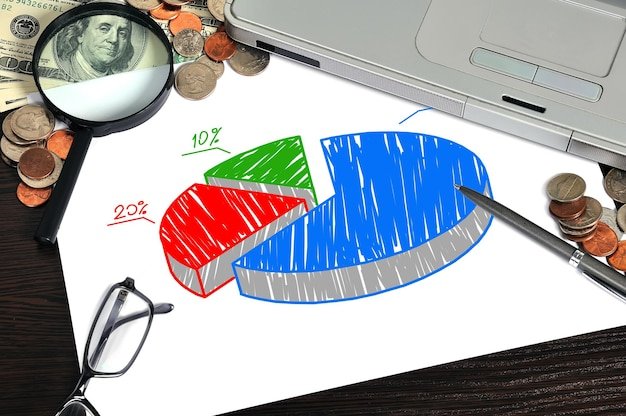Calculating the break-even point: a practical guide for business
-
Yulia Portnova
Copywriter Elbuz
Have you ever wondered why, despite successful sales, profits are not growing? The break-even point is the key. This is a concept without which it is impossible to imagine a sustainable business. Let's figure out how to calculate it correctly and what role it plays in your financial well-being. In one of my projects with an online store, we discovered a surprising pattern...

Glossary
- 📈 Break-even point: Sales volume or revenue level at which a company's income is equal to its costs, that is, the company does not make a profit, but does not incur losses.
- 📊 Fixed costs: Costs that remain the same regardless of production or sales volume (rent, employee salaries, depreciation of equipment).
- 📉 Variable costs: Costs that change depending on production or sales volume (raw materials, packaging, transportation) .
- 💸 Revenue: The total amount of money received from the sale of products or services.
- 📋 Contribution Margin: The difference between revenue and variable costs. This indicator helps determine what portion of the revenue remains after covering variable costs and goes to cover fixed costs and make a profit.
- 📎 Break-even analysis: An analysis technique that allows you to determine the sales volume required to cover all costs and evaluate the effect on profit when sales, costs and prices change.
- 📐 Break-Even Point Formula: Mathematical expression for calculating the break-even point. The formula commonly used is BEP = FC / (P - VC), where P is the selling price per unit.
- 💼 Discounting: A method of reducing future cash flows to their present value to evaluate investment projects.
- 💹 Sensitivity Analysis: A research method that shows how changes in one or more factors affect economic outcome.
- 🧾 Break-Even Sales: The number of products or services that must be sold to reach the break-even point.
What is the break-even point
When I started my business career, one of the first metrics I studied was the break-even point. This metric has proven to be incredibly useful as it helps us determine the point at which our revenues begin to cover all our business expenses.

Definition and importance of break-even point
The break-even point shows at what point the business becomes self-sustaining. This is an important indicator for every entrepreneur, as it allows you to determine what volume of products or services need to be sold to cover all costs. I remember how, for one of my first projects, I was able to calculate the break-even point and use this information to plan budgets and sales strategies.
Various names and formats
In different cases, the break-even point may be called differently:
- 📈 Equilibrium point
- 🎯 Profitability threshold
- ⚖️ Zero profit point
- 💸 Break-even price
Calculation of break-even point
The break-even point can be measured in physical or monetary terms. In my practice, I often use a formula that includes fixed and variable costs.
Formula: [{Break-even point} = \frac{Fixed costs}} {{Цена за единицу} - {Переменные затраты на единицу}} ]
Putting it into practice
One of the cases that stood out to me was at a café I was consulting for. We did a thorough analysis of all costs and determined that the break-even point would be reached when they sold 300 cups of coffee per day. This allowed us to:
- 📊 Optimize pricing policy
- 💡 Develop a marketing strategy
- 🚀 Increase sales

I I was convinced that a correctly calculated break-even point helps to avoid losses and allows you to build successful development strategies. It is necessary to take into account all types of costs so that the calculation is as accurate as possible.
Examples and results
In one of my retail projects, we used the break-even point to analyze the financial health of the company . After optimizing costs and revising the pricing policy, the company became profitable within 6 months. Examples show that proper management of the break-even point can lead to significant improvements in's business.
Best practices and tips
🚀 Collect accurate data – this will help avoid errors in calculations.
📊 Conduct regular analysis of - the company's financial condition may change.
🎯 Focus on the needs of the market - this will help optimize sales and costs.
I am confident that correct knowledge and use of the break-even point allows you to manage your business more efficiently and reduce financial risks.
| What things to do | What to avoid |
|---|---|
| Collect accurate cost data | Ignore variable costs |
| Review your pricing policy regularly | Don't consider seasonal changes |
| Use data to make decisions | Neglect market analysis |
I strongly recommend that all entrepreneurs master this tool because it opens up new horizons for business growth and development.

Benefits and disadvantages
Every time I come across a question about how to calculate the break-even point, I make sure to mention all the pros and cons of this indicator. Break-even point is a really important tool, especially for small and medium-sized businesses. It helps entrepreneurs understand at what point their income will begin to cover costs and the business will become profitable.
Break-even point benefits:
When I first calculated break-even point for my project, I was struck by its visibility. 📊 It was very easy to see how profit relates to fixed and variable costs, and also to see how sales volume affects profit. This information literally opened my eyes to the real financial performance of the business.
Here is an example of one of my projects. While creating an online store, I realized that I had to sell a certain number of items per month to cover all the costs. With the help of accurate calculations, I was able to clearly see this volume and plan my sales.

Easy calculation is another definite plus. Using a simple formula, I quickly and easily calculated my break-even parameter. This involved simply dividing fixed costs by the difference between selling price and variable costs per unit. The simpler the indicators, the easier it is to manage the business.
Disadvantages of the break-even point:
However, like any other instrument, the break-even point has its limitations. Calculation methods assume a stable market environment. But reality always makes its own adjustments. For example, it is difficult to take into account sharp fluctuations in such indicators as:
🔄 Demand: Consumer sentiment and seasonality greatly influence sales .
📉 Technologies: Rapid technological changes may require unexpected costs.
💼 Competition: The emergence of new competitors often affects market share.
In one of my projects, I was unpleasantly surprised when other players on the market began offering similar products at a lower price. This surge in competition significantly changed my forecasts, and the calculation of the break-even point became unreliable. In such a situation, it is important not only to rely on mathematical calculations, but also to quickly adapt to market conditions.

Table of advantages and disadvantages:
| Benefits | Disadvantages |
|---|---|
| 📊 Visualization | 🔄 Requires a stable market environment |
| ➕ Easy to calculate | 📉 Difficult to take into account seasonality, changes in demand and technology |
| 💡 Easy to analyze | 💼 Does not take into account sudden surges of competition |
I will emphasize that despite all the disadvantages, the break-even point remains an indispensable tool in managing the company’s financial flows. I recommend that you always use it to analyze current and future projects. Try to recalculate this indicator regularly to adapt to changing market conditions. I am sure that proper use of the break-even point will help you achieve financial stability and business success.
How to calculate the break-even point
Gathering the necessary information
The first step in calculating your break-even point is to collect all the necessary data about your business. I encourage you to carefully analyze the key parameters of your business, such as the volume of production and sales of goods, the level of profits and losses. In practice, working with small businesses, I often encountered the fact that entrepreneurs do not always take into account important details, such as seasonal fluctuations in demand and the cost of rental payments.

Companies are successfully targeting data collection
At this stage it is important to collect the following information:
- 📊 Variables costs of producing one unit of output.
- 💡 Fixed costs such as rent payments and staff salaries.
- 📈 Selling price of one unit of production.
Calculation of variable and fixed costs
The next step is to determine the variable and fixed costs. For my freelance projects, this was key because having a clear understanding of costs helps avoid unexpected losses. I highly recommend considering:
- 💥 Variable costs: raw materials, energy costs, transportation costs.
- 🔧 Fixed costs: rent, salaries, marketing.
Analysis of the obtained results
The last step is to analyze the obtained results. I am convinced that this helps the business pay correctly and avoid losses. The formula for calculating the break-even point is simple:
Break-even point (in units) = Fixed costs / (Sales price per unit - Variable costs per unit)Let me give you an example from my practice: when I worked with a manufacturer of double-glazed windows, our calculation looked like this:
- Fixed costs = 5500 euros/month
- Variable costs = 25 euros/piece.
- Selling price = 80 euros/piece.

Calculating using the formula, we got:
Break-even point = 5500 / (80 - 25) = 100 unitsThis means that to cover all costs it is necessary to sell 100 units. double-glazed windows per month. Once we reached this break-even point, our project began to make a profit.
Analysis of calculation results
Practical advice
In conclusion, I would advise you to:
- 💬 Review your expenses regularly.
- ⚙️ Implement analytical tools for production monitoring.
- 📌 Conduct regular meetings with financial advisors.
"I am convinced that a correct understanding of the break-even point leads to sustainable business development. It is important to monitor financial flows and adapt to market changes." – My experience suggests that this strategy is 100% justified.
Useful and not useful
| Useful actions | Unhelpful actions |
|---|---|
| Careful cost accounting | Neglecting small expenses |
| Regular financial analysis | Bet only on intuition |
| Consultations with experts | Ignoring professional advice |
I hope that my experience and tips will help you manage your business successfully. Good luck with your calculations and prosperity to your business!
Formulas for calculating the break-even point
When I'm in The first time I came across the calculation of the break-even point, I was struck by how important this indicator is for the stability of the business. I believe that every entrepreneur, especially freelancers and small businesses, should be able to do this, because it is a fundamental element of financial planning. The break-even point helps determine the minimum quantity of products or services that must be sold to cover all costs and avoid losses. Formulas for calculation vary, and I am ready to share with you what I use myself.

Break-even point in physical terms
To calculate the break-even point in physical terms (in units of production), I use the following formula:
Break-even point (in units) = Fixed costs / (Unit price - Variable costs per unit)
Let's look at an example for a freelancer who makes handmade wicker bags.
Calculation example:
- Unit price (bag ): 50 euros
- Cost of materials per unit: 23 euros
- Delivery cost per item: 3 euros
- Utilities and communication services per month: 30 euros
- Promotion on social networks per month: 15 euros
Fixed costs are:
- 💡 Utility bills and communication services: 30 euros
- 💡 Promotion in social networks: 15 euros
Total fixed costs: 45 euros. 
Variable costs include:
- 💡 Cost of materials per unit: 23 euros
- 💡 Cost of delivery per unit: 3 euros
Total variable costs: 23 + 3 = 26 euros.
According to the above formula (and my own calculations), the break-even point for our freelancer will be as follows:
Break-even point (in units) = 45 / (50 - 26) = 45 / 24 ≈ 1.875
This means that our freelancer you need to sell at least 2 bags per month to cover all your fixed and variable costs and not go into a loss.
Break-even point in monetary terms
For those who prefer to work with monetary indicators, you can calculate the break-even point in euros. To do this I use the formula:
Break-even point (in euros) = Fixed costs / (1 - (Variable costs / Unit price))
Let's use the same data from our example:
- Fixed costs: 45 euros
- Variable costs: 26 euros
- Unit price: 50 euros
Break-even point (euro) = 45 / (1 - (26 / 50)) = 45 / (1 - 0.52) = 45 / 0.48 ≈ 93.75 euros
This means that our freelancer needs to earn at least 93.75 euros monthly to stay afloat.

Results and recommendations
Based on my experience, I can confidently say that knowing your break-even point helps you make informed business decisions. I recommend that every entrepreneur periodically recalculate this indicator, since both product prices and costs may change.
Top tips for calculating your break-even point:
- 📊 Recalculate costs regularly.
- 📊 Consider all variable expenses, even those that seem insignificant.
- 📊 Use calculation to plan sales and marketing strategies.
For clarity, let's summarize everything in the table:
| Indicator | Significant | Comment |
|---|---|---|
| Fixed costs | Yes | Always consider them |
| Variable Costs | Yes | Remember to include all details |
| Unit Price | Yes | Evaluate this indicator honestly |
| Break-even sales | Yes | Calculate your real needs |
I hope that my experience will help you in your calculations and planning. Remember that the break-even point is an important indicator that should be taken into account in every business.
Profit day estimate
When I first realized the importance of the break-even point for my business, I immediately thought about how this information could help me manage financial flows. First of all, I decided to analyze on what day of the month my business becomes profitable. This turned out to be a key point in understanding the stability of my enterprise.

Let me give you an example from personal experience. I once worked with a flower pot company. We calculated that the break-even point was reached on the 23rd day of the month. 📅 This meant that out of 30 days in a month, 23 days the enterprise worked exclusively to cover costs, and only on the remaining seven days was profit generated. In my analysis, I realized that this situation was risky, since any unforeseen event, such as a delay in deliveries or a decrease in demand, could easily lead the company to losses.
To prevent negative consequences, I suggested revising the cost structure and increasing sales at the beginning of the month. So the company was able to move the break-even point to the middle of the month on the 15th day. 🚀 This significantly reduced risks and allowed us to remain profitable even in the event of unforeseen situations.
To make your break-even point a useful tool for your business, I recommend the following steps:
🎯 Determining the day to reach profit: Once the break-even point is known, it is important to understand On what day of the month does the business become profitable? This will allow you to assess the stability of the enterprise.
📈 Cost Analysis: Estimate your fixed and variable costs. Try to reduce fixed costs so that the break-even point is reached as quickly as possible.
🔍 Sales monitoring: Analyze sales and try increase sales volume at the beginning of the month in order to exceed the break-even point as quickly as possible.
📊 Planning and Forecasting: Use data about break-even point to create realistic forecasts and plans for future periods. This will help maintain stable growth and avoid unexpected losses.

For example, for my leather accessories project, we were also able to move the break-even point from the 20th to the 10th day of the month. This gave us more financial flexibility and allowed us to invest in new projects.📌
| CORRECT ACTIONS | INCORRECT ACTIONS |
|---|---|
| Determining the profit day | Ignoring break-even point analysis |
| Fixed cost analysis | Refusal to review the cost structure |
| Increase in sales volume | Focus only on covering costs |
| Realistic Forecasts | Sloppy Planning |
Based on my experience, I can confidently say that the break-even point allows you to better control the financial sustainability of the business. I am confident that following these guidelines will help you strengthen your company and reach new heights.
Final recommendations for entrepreneurs on controlling the break-even point
I believe that regularly monitoring your break-even point is a fundamental element of running a successful business. This indicator allows an entrepreneur not only to understand what stage their business is at, but also to assess the overall effectiveness of management decisions. From my experience, knowing the profitability threshold clearly demonstrates how correct decisions are made in the company and how optimized costs are.

📊 Example from my practice: In one of my projects, when we began regularly tracking the break-even point, we discovered that marketing costs were unreasonably high. After analysis, we reallocated the budget, and the results exceeded all expectations - sales increased by 25% and costs decreased by 15%.
From my own experience, I was convinced that the break-even point helps:
- 📈 Increase sales: By determining the optimal level of sales that covers all costs, you can set reasonable goals for the team.
- 💰 Adjust price: This metric helps you understand which pricing changes will bring the most benefit.
- 📉 Optimize costs: Understanding the cost structure allows you to find weaknesses and reduce costs.
⚙️ Practical steps to calculate and control your break-even point:
- Collect data on fixed and variable costs. I highly recommend carefully considering all costs to get an accurate idea of your current costs.
- Determine gross margin. This will help you understand how much income goes towards covering fixed costs.
- Calculate the break-even point. The formula is simple: ({Fixed costs} \div \{Gross margin}).
- Analyze and adjust. Review this indicator regularly to always be aware of the current state of affairs.
🔍 Example calculations from the project:
- Fixed costs: 5000 euros
- Variable costs per unit: 2 euros
- Selling price per unit: 5 euros
- Gross margin: (5 - 2 = 3) euros
- Point break-even: (5000 \div 3 \approx 1,667) units of production
Solution applicable in practice: start by analyzing the cost structure and looking for opportunities for them optimization.

Use data and approaches described above to maximize the efficiency of your business. I believe that constantly tracking your break-even point will allow you to confidently move towards a successful future.
| What's useful | What to avoid |
|---|---|
| 📊 Regular calculation of the break-even point | ❌ Ignoring variable and fixed costs |
| 🔍 Cost structure analysis | ❌ Setting too high prices without analysis |
| ✏️ Cost optimization | ❌ Lack of control over prices and sales |
I would recommend entrepreneurs to actively use these tips and monitor the dynamics of the break-even point for sustainable business development.
MediaMarkt expertise
MediaMarkt is one of the largest European retailers of electronics and household appliances. The company has been operating for more than forty years, and during this time it has established itself as a reliable and innovative supplier. Main goals and objectives: increase sales, attract new customers, retain existing ones and provide a high level of service.

Main Objectives
- Increase in profit 💼.
- Optimization of operating expenses 📉.
- Increased customer satisfaction 😊.
- Developing growth and expansion strategies 🌍.
Main problem
Determining break-even point is a critical aspect for MediaMarkt. The company sells many products, each of which has its own costs for procurement, logistics, storage and promotion. Understanding at what stage sales begin to make a profit allows you to more accurately plan promotions, manage inventory and optimize costs.
Characteristics and interests of the target audience
Target audience MediaMarkt includes:
- Young professionals 👨💻 who need the latest innovations in electronics for work and leisure.
- Couples 👨👩👧👦 looking for reliable home appliances.
- Gadget lovers 📱 interested in the latest technology trends.

Key interests
- Product quality 🔝.
- Price 💲 and discounts 🎯.
- Ease of purchase 🛒 and fast delivery 🚚.
Project implementation
MediaMarkt hired consultants to provide detailed calculations of break-even points for various product categories. Key steps included:
- Fixed and variable cost analysis.
- Calculated break-even points for each product category.
- Implementation of software solutions for monitoring.
Calculation example
Product category: Smartphones
Formula: Break-even point = Fixed cost / (Price per unit - Variable cost per unit )
| Indicator | Value |
|---|---|
| Fixed costs | €100,000 |
| Price per smartphone | €500 |
| Variable costs | €300 |
| Break-even point | €100,000 / (€500 - €300) = 500 units |

This meant that MediaMarkt needed to sell at least 500 smartphones to cover your fixed and variable costs and reach break-even point.
Analysis and results
After implementing the strategy, MediaMarkt succeeded:
- Reduced operating costs by 15% 🎉.
- Increase the total profit of by 10% 📈.
- Reduce balances in warehouses by 20% 📦.
Conclusion
Study and analysis of break-even point helped MediaMarkt optimize their processes and make more informed decisions. This improved financial performance and strengthened the company's competitive position in the market.

Frequently asked questions on the topic: Calculating the break-even point: a practical guide for business
What is break even?
The break-even point is the volume of sales or income at which the company's revenue completely covers its costs and profit is zero.
What is the break-even point for?
The break-even point helps determine the minimum sales volume required for the business not to operate at a loss. This is important for planning and assessing financial sustainability.
How to calculate the break-even point?
The break-even point is calculated using the formula: TB = Fixed costs / (Price per unit - Variable costs per unit).
What are the benefits of knowing your break-even point?
Knowing the break-even point allows you to make informed decisions about pricing policy, production volume and marketing strategies, as well as assess the level of business risk.
What are the disadvantages of break-even point analysis?
Break-even point analysis may be limited in that it does not take into account changes in variable costs as production volume changes and may base its calculations on simplified assumptions.
What formulas are used to calculate the break-even point?
To calculate the break-even point, the following formulas are used: break-even point in units = Fixed costs / (Price per unit - Variable costs per unit) and break-even point in in monetary terms = Fixed costs / (1 - Variable costs / Revenue).
Can you use an example to explain the calculation of the break-even point?
Yes, you can use an example for better understanding. For example, if a company produces a product with a price of 1 euro, variable costs of 0.6 euros and fixed costs of 200 euros, the break-even point would be 500 units (200 / (1 - 0.6)).
What does break-even point analysis include?
Break-even point analysis involves estimating fixed and variable costs, setting a price for a product, and analyzing how changes in these factors affect the break-even point and profitability of the business .
How often should you recalculate your break-even point?
The break-even point should be recalculated when there are significant changes in costs, product prices, or sales volume to maintain current information about the financial health of the business.
Is it possible to use the break-even point for short-term planning?
Yes, the break-even point is a useful tool for short-term planning, as it allows you to determine the minimum sales volumes to cover current costs and evaluate various development scenarios.
Thank you for reading! 🌟
Now that you know what the break-even point is and know how to calculate it, you have the key to success of your business. 🚀 As an expert in analyzes and forecasts, I see you at the top. Don't forget that your knowledge is now valuable not only to you, but also to your environment. Feel free to apply them in practice , and the result will not be long in coming. 💡 Leave comments so I know your opinion and impressions.
Author: Yulia Portnova, independent expert "Elbuz"
Words are my tool in creating a symphony of online store automation. Welcome to my literary cosmos, where every idea is a star on the path to a successful online business!

- Glossary
- What is the break-even point
- Benefits and disadvantages
- How to calculate the break-even point
- Formulas for calculating the break-even point
- Profit day estimate
- Final recommendations for entrepreneurs on controlling the break-even point
- MediaMarkt expertise
- Frequently asked questions on the topic: Calculating the break-even point: a practical guide for business
- Thank you for reading!
Article Target
Explain the importance of the break-even point and teach how to calculate it.
Target audience
small and medium-sized entrepreneurs, economics students, business analysts
Hashtags
Save a link to this article
Yulia Portnova
Copywriter ElbuzWords are my tool in creating a symphony of online store automation. Welcome to my literary cosmos, where every idea is a star on the path to a successful online business!
Discussion of the topic – Calculating the break-even point: a practical guide for business
Information about what the break-even point is, why it is needed and how to calculate it. Examples to make the information practical and useful to the reader.
Latest comments
15 comments
Write a comment
Your email address will not be published. Required fields are checked *

























Юлия Портнова
The break-even point is an important financial indicator for a business. It shows how many units of a product need to be sold to cover all costs. For example, if your fixed costs are 1000 rubles, and your variable costs per unit are 50 rubles, and the selling price is 100 rubles, then the break-even point will be 20 units.
Hans Müller
Julia, thanks for the example! What strategies can be applied to reduce fixed costs? 💡
Julia Smith
Hans, good questions! I think one strategy might be to rent rather than buy equipment. This allows you to distribute costs over time.
Carlos García
Great idea, Julia and Julia! But what about increasing the price of a product? What are the risks? 📈
Marie Dubois
By the way, Carlos, the risk is that you can lose some clients who are not willing to pay more. You need to research the market.
Giuseppe Rossi
I agree with Marie, by the way! We somehow raised prices at the factory and faced an outflow of customers. I had to lower the price back in order to survive.
Olek Kowalski
You're all too optimistic. The market does not tolerate such experiments, and the break-even point is a relative concept. You won't say anything new.
Clara Fernández
Olek, maybe you’re right, but without calculations and analysis it’s generally difficult to understand how to develop further. I always check the break-even point before starting new projects.
Юлия Портнова
Carlos, raising prices is always risky. You need to take into account the elasticity of demand for your product. Strategies such as providing additional services or improving quality can be used to justify increasing the price.
Emma Johnson
Interesting! Are there any automated tools for calculating the break-even point? 🤔
Hans Müller
Emma, yes, there is. For example, you can use Excel or specialized programs for financial analysis. This helps a lot!
Julia Smith
I always use Excel, it helps me a lot too. But if anyone knows better tools, please share!
Carlos García
In general, there are many solutions. I've personally tried QuickBooks, but it's a bit pricey for a small business. Which ones do you use?
Emma Johnson
Maybe you should try online calculators? You can often find free solutions there.
Юлия Портнова
All suggestions are good, the main thing is to carefully analyze the data. Even a small business needs a competent approach to financial planning!